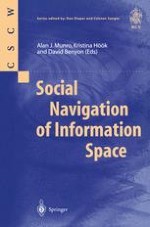Social navigation is a vibrant new field which examines how we navigate information spaces in "real" and "virtual" environments, how we orient and guide ourselves, and how we interact with and use others to find our way in information spaces. This approach brings a new way of thinking about how we design information spaces, emphasising our need to see others, collaborate with them, and follow the trails of their activities in these spaces. Social Navigation of Information Space is the first major work in this field, and includes contributions by many of the originators and key thinkers. It will be of particular interest to researchers and students in areas related to CSCW and human computer interaction. As a thoroughly multi-disciplinary topic, it will also be of interest to researchers in cognitive psychology, social psychology, philosophy, linguistics, sociology, architecture and anthropology.
